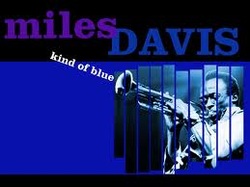 Listening to Kind of Blue this week. This album is said to be the foundation of modern jazz. It has a lot to live up to! Jazz is a genre which emerged from the blues around the end of the 19th century and early 20th century. But jazz developed from and went beyond the blues. Miles Davis recorded Kind of Blue in 1959 - which is about half way between the origin of jazz and present day. It marked a new way of working for musicians. Before this, musicians worked with a set melody and backing etc. Miles Davis pioneered modal jazz. Worth mentioning though that the theory behind this way of working was developed by a friend of Miles - George Russell. Russell spent the better part of the '50s devising a new theory of jazz improvisation based not on chord changes but on scales or "modes." He explained this to Miles one night over the piano and Miles saw the potential. But he needed to find a pianist that could understand it well enough who could play and signpost the chords for his other musicians - like a musical compass. The answer was Bill Evans, a classicly trained pianist but with an amazing feel for what Miles wanted to do. The track "So What" from this album is still held up today as a fantastic example of this new way of working in jazz which is still the foundation of jazz today. 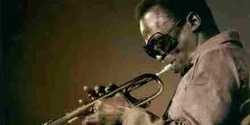 Miles Davis "So what" is a long track - over 9 minutes but it has a 32 bar structure at its core. It begins with an intro which is about 16 bars gradually builds, followed by several sections where each musician takes a solo of 32 bars, then an outro. Who were the musicians? Miles Davis on trumpet, Paul Chambers on bass, Cannonball Adderly and John Coltrane on saxophones, Jimmy Cobb , Drummer, and Bill Evans on piano - all first class musicians!. 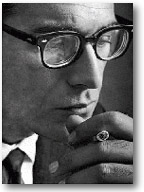 Bill Evans Its said that Miles Davis and Bill Evans were amazingly in tune with each other as musicians to the point that Miles Davis used to ring Bill up and ask him to play down the phone. So Bill was the inspiration behind a lot of the harmonies and was influential in Miles' music. More on that later. So What is elegant in its simplicity. It centres around two chords C and D minor7. The rythymn is swung 4/4. The transcription asks that it be played "Slowly and Freely in an attempt to capture the spirit of the recording. But the piece was almost entirely improvised at the time - with no detailed sheet music available to the players. The intro begins with minimal instrumentation - just piano and bass, initially with a question and answer. Chambers begins the introduction with 3 simple notes - an upbeat of two quavers and a minim - A, C and an unexpected G sharp (Am7) . The structure of the intro involves 8 bars on the same chord, then 4 bars with a variation, then back to the original chord for four bars. Bill Evans on piano picks up on the last bass note and then answers with two chords. This pattern runs through to the third bar with various variations and resolves on a C chord. Then both players break into playing in perfect unison (must have been planned) with a longer riff of semiquavers, and minims. Next the bass holds D semibreves and is accompanied by the piano over the top followed by bass riff ending in Eb and a 2/4/ bar. Then the distinctive bass riff and driving rythymn begins around bar 12, with swung semiquavers and answered by piano with two chords, this repeats x3 and then the bass ends the phrase with a simplified rythmn on E,D and A. Second time round, the saxophones (Coltrane and Adderly) and the trumpet (Miles Davis) join Bill Evans answering with the two chords. The underlying chord is Dm7 . The sequence is repeated in Eb7m then back down in Dm7. On the last riff of the sequences there is no answer (planned or signalled?). When the melody starts, a walking bass drives the tempo all the way through. The drums also feature a persistent ride cymbal all the way through. Each of solos is 32 bars - 8 bars on the first chord then 4 on the second, then 12 on the first then 4 and 4. Each of the solos has this structure underlying it. Apparently this was totally unplanned. Miles Davis would just wander around pointing at people when it was his turn to play. However the calibre of the musicians and their responsiveness to each must have brought some order to this almost subconsciously. 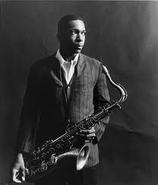 John Coltrane You can hear how they respond to each others playing in the music. The first solos features trumpet, with Miles Davis launching it in Em7 for eight bars, into Fm7 for four then back to Em7 and so on. The piano plays fairly sparingly underneath and responds with a syncopated rhythm and fills. Next is Coltrane on tenor Saxophone. His solo begins by responding to the smooth feel of Miles Davis with similar dotted quavers and ties. He then stamps his own mark , becoming much more elaborate with the use of semi and demi semi quavers and many triplets. In fact he seems to play as many notes as possible! And does so brilliantly. The chord changes are the same as before. 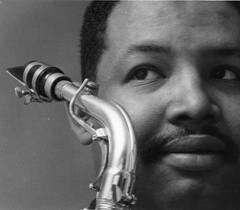 Cannonball Adderly Adderly is next to play on alto sax and his solo seems to begin in Bm7, then to Cm7 and so on. He emphasises the Cm7 by landing and holding the top B. His style seem in between the two previous players, very elaborate and fast in some phrases especially at the beginning and on ascending phrases in response to Coltrane. But bringing it back to swung semi quavers in other sections. He uses a trill too. Bill Evans on the piano begins in Dm7. The other instrument take over the backing chords. Then he switches in Ebm7. He uses a few triplets (across minims) and also swung rythmn. Evans solo finishes with the bass picking up a riff which includes a triplet - perhaps responding to the feel of Bill Evans' solo. The outro echoes the intro with the same bass riff, question and answer structure, with the instruments dropping out in reverse order until down to bass and piano. Kind of Blue was not just remarkable for "So What". It had a number of landmark tracks. Flamenco Sketches is another track based on improvisation with Coltrane in particular enjoying the challenge. Evans apparently wrote out five scales and said to the musicians to play in the notes of these scales. It would be up to each soloist how they interpreted this. The track is much slower. "All blues" and " Freddy Freeloader" are also great tracks with great solos thoughout. "Freddie Freeloader" was the album's only conventional blues. For this track alone, Miles let his usual pianist, Wynton Kelly, a straight blues-and-bebop keyboardist, sit in for Evans. Whereas "All Blues" is said to be the most fully developed piece of "modal" jazz" on Kind of Blue. Its amazing that Kind of Blue was so perfect and is tribute to the musicians. In a way, that is what is testing about improvisation. You can't go back and do it again. And how successful it is depends on the calibre of the musicians and their understanding of what they are trying to do. Miles Davis was a brilliant recruiter and picked the right team for this never to be repeated recording. Unfortunately the band broke up soon afterwards with the musicians going their own ways. But the method pioneered on this album - modal jazz - went from strength to strength.
0 Comments
Your comment will be posted after it is approved.
Leave a Reply. |
Fiona Harrison
|

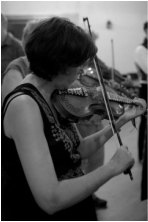
 RSS Feed
RSS Feed
